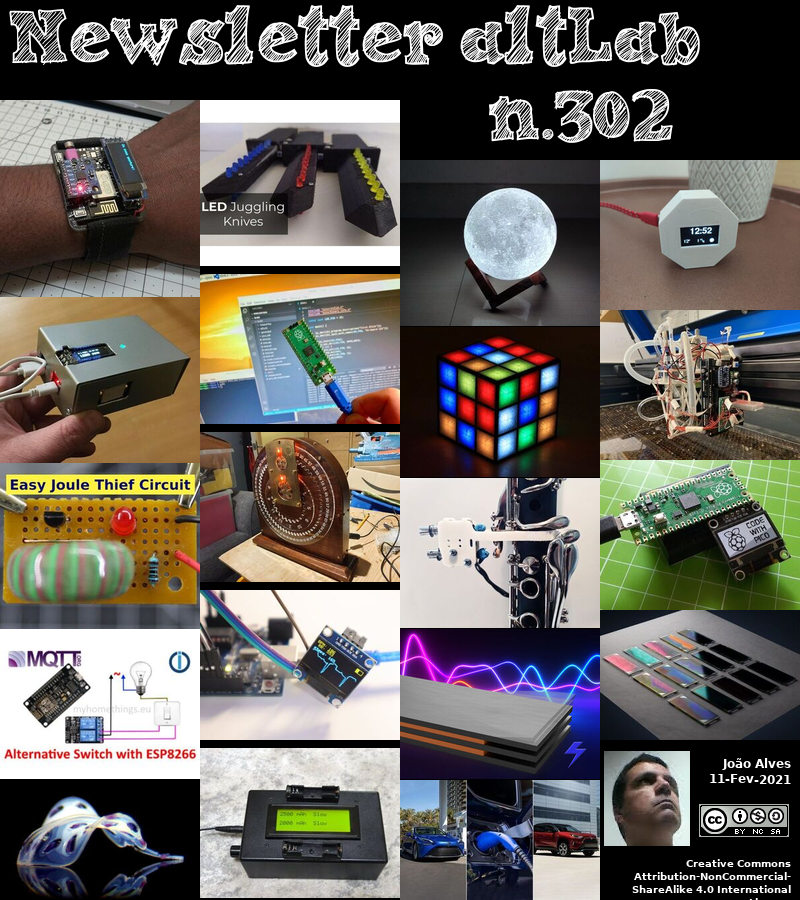2021-02-11 - Nº 302
Editorial
Esta é a Newsletter Nº 302 que se apresenta com o mesmo formato que as anteriores. Se gostar da Newsletter partilhe-a!
Todas as Newsletters encontram-se indexadas no link.
Esta Newsletter tem os seguintes tópicos:
Faz hoje anos que nascia, em 1800, o inventor, matemático, químico, físico, filólogo e egiptólogo inglês Henry Fox Talbot. Ele inventou o processo fotográfico negativo-positivo. Ele melhorou a descoberta de Thomas Wedgwood (1802) de que escovar uma solução de nitrato de prata no papel produz um meio sensível à luz capaz de registar imagens negativas, mas Wedgewood não foi capaz de controlar o escurecimento. Em Fevereiro de 1835, Talbot descobriu que uma solução forte de sal fixa a imagem. Usando uma câmara obscura para focar uma imagem no seu papel para produzir um negativo, e ao expor uma segunda folha de papel à luz do sol transmitida pelo negativo - ele foi o primeiro a produzir uma imagem positiva da qual foi capaz de fazer mais cópias à vontade. Seu Pencil of Nature (1844) foi o primeiro livro ilustrado fotograficamente.
Faz também hoje anos que nascia, em 1839, o físico matemático e químico norte-americano Josiah Willard Gibbs. Ele ficou conhecido pelas suas contribuições à análise vectorial e como um dos fundadores da físico-química. Em 1863, ele recebeu o primeiro doutoramento em engenharia da Universidade de Yale. O seu principal trabalho foi no desenvolvimento da teoria termodinâmica, que trouxe a físico-química de uma investigação empírica para uma ciência dedutiva. Em 1873, ele publicou dois artigos sobre a natureza fundamental da entropia de um sistema, e estabeleceu a “superfície termodinâmica”, um método geométrico e gráfico para a análise das propriedades termodinâmicas das substâncias. O seu famoso "On the Equilibrium of Homogeneous Substances", publicado em 1876, estabeleceu o uso de “potencial químico”, agora um conceito importante em físico-química.
Faz igualmente hoje anos que nascia, em 1847, o inventor norte-americano Thomas Edison. Ele detinha um recorde mundial de 1.093 patentes (incluindo as detidas em conjunto) e criou o primeiro laboratório de pesquisa industrial do mundo. Ele mostrou desde cedo uma curiosidade por explicações de como tudo funcionava e estava especialmente interessado em química. Ele começou a vender jornais na ferrovia aos 12 anos e aprendeu a operar um telégrafo. Em 1868, sua primeira invenção foi uma máquina eléctrica de registo de votos. Em 1869, ele fez melhorias no ticker da bolsa. Em 1876 ele mudou o seu laboratório para Menlo Park, N.J., onde inventou seu fonógrafo (1877) e o primeiro protótipo de uma lâmpada eléctrica incandescente comercialmente prática (1879). Outras invenções incluíram baterias de armazenamento, um ditafone e um mimeógrafo. No final da década de 1880, ele fez filmes e, em 1912, estava a fazer experiências com filmes falados. Edison desenvolveu energia eléctrica a partir de estações geradoras centrais. Ele se tornou conhecido internacionalmente como “o Mágico de Menlo Park”.
Faz também hoje anos que nascia, em 1866, o químico alemão Fritz Hofmann. Ele polimerizou o isopreno para criar borracha sintética (1909) enquanto trabalhava como químico sénior para o vorm Elberfelder Farbenfabriken. Friedr. Bayer & Co. O processo recebeu a primeira patente mundial para um “Método para produzir borracha sintética” (número alemão 250690 em 12 de Setembro de 1909). Começou a resolver o problema do alto custo da borracha natural conforme a necessidade aumentava na era do transporte motorizado. Hofmann seguiu a liderança revelada por Carl Dietrich Harries, que em 1905 quebrou a borracha natural usando ozónio para revelar que ela era formada por longas cadeias nas quais centenas de moléculas de isopreno estão ligadas. Hofmann também estudou a polimerização de butadieno e 2,3-dimetil butadieno.
Faz igualmente hoje anos que nascia, em 1898, o físico húngaro-americano Leo Szilard. Ele conjuntamente com Enrico Fermi, projectou o primeiro reactor nuclear que sustentou a reacção nuclear em cadeia (2 de Dezembro de 1942). Em 1933, Szilard trocou a Alemanha nazi pela Inglaterra. No mesmo ano, ele concebeu a reacção em cadeia de neutrões. Depois da mudança para Nova Iorque, em 1938, ele conduziu experiências de fissão na Universidade de Columbia. Ciente do perigo da fissão nuclear nas mãos do governo alemão, ele persuadiu Albert Einstein a escrever ao presidente Roosevelt, instando-o a encomendar o desenvolvimento americano de armas atómicas. Em 1943, o Major General Leslie Groves, líder do Projecto Manhattan que projectou a bomba atómica, forçou Szilard a vender seus direitos de patente de energia atómica ao governo dos Estados Unidos.
Por fim, faz hoje anos que nascia, em 1915, o cientista da computação e matemático norte-americano Richard Hamming. Ele desenvolveu códigos de Hamming para computadores - códigos de detecção e correcção de erros (1947). Eles adicionam um ou mais bits à transmissão de blocos de dados, usados para uma verificação de paridade, para que os erros possam ser detectados e corrigidos automaticamente. Ao tornar desnecessário o reenvio de dados com erros, a eficiência melhorou para modems, discos compactos e comunicações por satélite. Ele também trabalhou em linguagens de programação, análise numérica e a janela espectral de Hamming (usada para suavizar dados antes da análise de Fourier ser realizada). Ele ensinou na Universidade de Louisville, então durante a Segunda Guerra Mundial trabalhou (1945) em computadores com o Projecto Manhattan para a criação da bomba atómica.
Nesta semana que passou ficámos a saber que chegaram à órbita de Marte, não uma mas duas sondas. A primeira que chegou "Amal" que significa esperança em árabe foi lançada à sete meses atrás e entrou no passado dia 9 de Fevereiro. Viajando a cerca de 120.000 Km/h (em relação ao Sol) a sonda precisou de executar uma queima durante 27 minutos para abrandar a velocidade. A manobra, realizada por seis propulsores da sonda, começou por volta das 19:30 GST (15:30 GMT), com confirmação recebida na Terra cerca de 11 minutos depois - sendo o atraso relacionado com o tempo que os sinais de rádio levaram para atravessar o 190 milhões de quilómetros entre Marte e a Terra. Esta sonda foi enviada pelo Emirados Árabes Unidos é considerada um triunfo para uma pequena nação do golfo que ousou pensar, sete anos atrás, que poderia inspirar a próxima geração ao lançar a primeira missão espacial interplanetária árabe.
A segunda sonda, a Tianwen-1, foi lançada pela China em Julho do ano passado, e chegou à órbita de Marte no passado dia 10 de Fevereiro. Os engenheiros planearam uma queima de 14 minutos no propulsor de 3.000 newtons do orbitador, com a expectativa de que isso reduziria sua velocidade de 23 km/s o suficiente para permitir a captura da sonda pela gravidade de Marte. Esta sonda tem cerca de 5 toneladas e é composta por por um orbitador e por um rover solar. A ideia é larga o rover solar de cerca de 250 Kg numa região chamada Utopia Planitia, uma cratera gigante de 3300 km de diâmetro na superfície de Marte.
Para concluir, ainda é esperado que chegue mais uma sonda a Marte ainda este mês. Esta planeado para a próxima semana chegar a sonda Perseverance da NASA.
Na Newsletter desta semana apresentamos diversas noticias, artigos científicos assim como projetos de maker. É apresentada a revista newelectronics de 9 de Fevereiro.
 João Alves ([email protected])
João Alves ([email protected])
O conteúdo da Newsletter encontra-se sob a licença  Creative Commons Attribution-NonCommercial-ShareAlike 4.0 International License.
Creative Commons Attribution-NonCommercial-ShareAlike 4.0 International License.
Novidades da Semana

Emirates Mars Mission: Hope spacecraft enters orbit
"The United Arab Emirates is celebrating its first mission at Mars. It has put a probe called Hope in orbit around the planet, making it only the fifth spacefaring entity to do so after the US, the Soviet Union, Europe and India. The spacecraft, which left Earth seven months ago, had to make a braking manoeuvre to be sure of being captured by Mars' gravity. UAE scientists can now look forward to studying the planet's atmosphere. Their satellite carries three instruments that will observe, among other targets, how neutral atoms of hydrogen and oxygen - remnants from Mars' once abundant water - leak into space. In the process, Hope will return spectacular, high-resolution, full-disk images of the planet." [...]
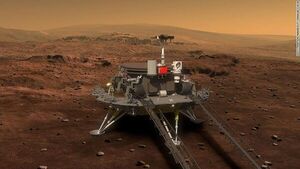
China Mars mission: Tianwen-1 spacecraft enters into orbit
"China says it has successfully put its Tianwen-1 mission in orbit around Mars. It's the first time the country has managed to get a spacecraft to the Red Planet and comes a day after the United Arab Emirates accomplished the same feat. Tianwen-1, or "Questions to Heaven", comprises an orbiter and a rover. Engineers will bide their time before despatching the wheeled robot to the surface but the expectation is that this will happen in May or June. Wednesday's orbit insertion underlines again the rapid progress China's space programme is making. It follows December's impressive mission to retrieve rock and soil samples from Earth's Moon - by any measure a very complex undertaking." [...]
Outras Notícias

Microchip Unveils First Fully Integrated Solution for Vehicle Ethernet Audio Video Bridging
"As connected vehicles increasingly rely on Ethernet for network connectivity, smart technology is helping developers to streamline infotainment system development and quickly adapt to manufacturers’ evolving requirements. Microchip Technology Inc. (Nasdaq: MCHP) today announced the first hardware-based audio endpoint solution for AVB – the LAN9360, a single chip Ethernet controller with embedded protocols. Microchip’s LAN9360 audio endpoint controller interconnects vehicles’ infotainment devices including speakers, amplifiers, microphones, navigation systems, radio tuners and smart headrests with Ethernet AVB. The LAN9360 bridges audio between Ethernet AVB and Inter-IC Sound (I2S™), Time Division Multiplexing (TDM) and Pulse Density Modulation (PDM) local audio interfaces. It completely supports audio transmission over Ethernet AVB, including generalized Precision Time Protocol gPTP, timestamping, transport protocols and content protection with High-bandwidth Digital Content Protection (HDCP). It also supports secure boot and secure remote updates over Ethernet." [...]

IBM Breaks New Ground with its Highest-Capacity Flash Storage System in a Small Form Factor; Aids Businesses on their Hybrid Cloud Journeys
"IBM today announced new high-speed, entry-level flash storage systems, as well as hybrid cloud and container-centric updates, all designed to help make enterprise-class storage accessible to businesses of all sizes and needs. The need for high capacity, cost-effective storage is on the rise as global data creation is expected to balloon to 143 zettabytes by 2024, according to IDC. [1] That need is amplified by accelerated digital transformations spurred by the pandemic. A recent study by IBM's Institute for Business Value, COVID-19 and the future of business, for example, reported that 59 percent of companies surveyed have accelerated digital transformation plans due to the pandemic. "The data needs of business have become critical since the pandemic," said Deney Dentel, President and CEO, Nordisk Systems, a Converge Company, an IBM Premiere Business Partner. "Enterprise class data availability, massive scalability, and the flexibility to access and manage data across hybrid clouds are imperatives." [...]
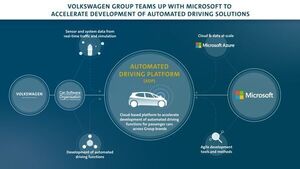
Volkswagen Group teams up with Microsoft to accelerate the development of automated driving
"Volkswagen Group further strengthens its capabilities in the development of automated driving (AD) solutions. The Group’s software company Car.Software Organisation will collaborate with Microsoft to build a cloud-based Automated Driving Platform (ADP) on Microsoft Azure and leverage its compute and data capabilities to deliver automated driving experiences even faster at global scale. With ADP running on Azure, Car.Software Organisation will increase the efficiency of the development of advanced driver assistance systems (ADAS) and AD functions for passenger cars across Volkswagen Group brands. Volkswagen and Microsoft have been strategic partners on the Volkswagen Automotive Cloud since 2018, which will span all of Volkswagen’s future digital services and mobility offerings. “As we transform Volkswagen Group into a digital mobility provider, we are looking to continuously increase the efficiency of our software development. We are building the Automated Driving Platform with Microsoft to simplify our developers’ work through one scalable and data-based engineering environment." [...]
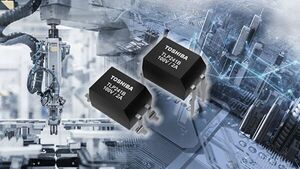
Toshiba Launches 100V High-current Photorelay for Industrial Equipment
"Toshiba Electronic Devices & Storage Corporation (“Toshiba”) has launched "TLP241B," a high-current photorelay in a DIP4 package for industrial equipment such as programmable logic controllers and I/O interfaces. Samples and production quantities are available now. TLP241B has integrated MOSFET based on Toshiba’s latest generation of U-MOS process. With TLP241B, the OFF-state output terminal voltage is extended to 100V, a 150% improvement from the 40V of the current TLP241A. It is housed in a versatile DIP4 package, and is the industry’s first[1] DIP4 packaged product to deliver 100V OFF-state output terminal voltage, 2A ON-state current and 5kV isolation voltage. This rating expansion covers a variety of applications." [...]
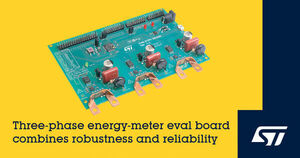
Complete Energy-Meter Evaluation Board from STMicroelectronics Combines Low-Cost Sensors and Robust Galvanic Isolation
"Accelerates time to market leveraging ST’s long expertise in utility and industrial metering applications A new evaluation board from STMicroelectronics speeds design of 3-phase AC Watt meters that meet the most stringent international quality and accuracy standards using low-cost, electromagnetic-immune shunt sensors and advanced galvanic-isolation technology for superior reliability and robustness. The EVALSTPM-3PHISO evaluation board combines the high-accuracy STPMS2 metering front-end IC and the advanced STISO621 digital isolator, with customizable turn-key firmware running on an STM32 microcontroller to compute metrology and power-quality data. The sensing circuitry and PCB layout are optimized to ensure robustness against EMI and a strong signal-to-noise ratio, for high-accuracy measurement and post-processing computation. The STPMS2, a two-channel 24-bit second-order sigma-delta modulator, measures voltage and current for each phase through an on-board voltage divider and a shunt current sensor. It then oversamples the signal using a synchronized 4MHz clock distributed by the microcontroller and multiplexes voltage and current sigma-delta bitstreams on a single output pin. Three STPMS2 are used in the 3-phase system to collect voltage and current data from each phase." [...]

Toyota to Debut Three New Electrified Vehicles for U.S. Market
"Toyota Motor North America (TMNA) announced plans to debut in the U.S. market this year, three new electrified models – two BEVs and a PHEV. “We continue to be leaders in electrification that began with our pioneering introduction of the Prius nearly 25 years ago,” said Bob Carter, TMNA executive vice president of sales. “Toyota’s new electrified product offerings will give customers multiple choices of powertrain that best suits their needs.” The new electrified models further expand Toyota’s U.S. leadership in alternative powertrain vehicles. Toyota has over 40% share of the total alternative fuel vehicle market, which includes a 75% share of the fuel cell market and a 64% share of hybrids and plug-ins. By 2025, Toyota’s goal is to have 40% of new vehicle sales be electrified models, and by 2030 expects that to increase to nearly 70%. Globally, Toyota hybrid vehicles sold have avoided an estimated 139 million tons of greenhouse gas (GHG) into the atmosphere." [...]
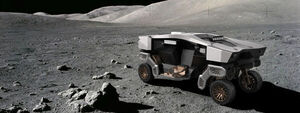
Hyundai Unveils TIGER Uncrewed Ultimate Mobility Vehicle Concept
"Hyundai Motor Group has revealed TIGER (Transforming Intelligent Ground Excursion Robot), the company’s second Ultimate Mobility Vehicle (UMV) and the first designed to be uncrewed. The transforming intelligent ground excursion robot is designed to carry various types of payload while traveling over challenging terrain. TIGER is being developed by Hyundai Motor Group’s New Horizons Studio, headquartered in Mountain View, California. The studio was established in late 2020 to develop UMVs drawing on research and innovation leadership from Silicon Valley and other innovation hubs. Concept vehicle showcases capability across remote and inaccessible terrain TIGER’s exceptional capabilities are designed to function as a mobile scientific exploration platform in extreme, remote locations. Based on a modular platform architecture, its features include a sophisticated leg and wheel locomotion system, 360-degree directional control, and a range of sensors for remote observation." [...]

Sentinel-6 passes in-orbit tests with flying colours
"In November 2020, the Copernicus Sentinel-6 Michael Freilich satellite was launched into orbit from the Vandenberg Air Force Base in California, US. Now, months later, the satellite has successfully passed what is known as the ‘in-orbit verification phase’, where its equipment is switched on and the instruments’ performance is checked. The Copernicus Sentinel-6 Michael Freilich satellite is the first of two identical satellites to provide critical measurements of sea-level change. The satellite carries a new digital altimeter, Poseidon-4, that uses dedicated onboard processing to return even more precise measurements of the height of the sea surface. In the satellite’s early days post-launch, the dedicated flight control team at ESA’s Operations Centre in Darmstadt, Germany, took meticulous care of the new Sentinel in what is known as the Launch and Early Orbit Phase (LEOP). Once completed, ESA’s mission control team handed over command and control of the satellite to Eumetsat – Europe’s weather and climate satellite organisation – who took over responsibility of commissioning, routine operations and distribution of the mission’s vital data." [...]
Renesas and Dialog Semiconductor to Join Forces to Advance Global Leadership in Embedded Solutions
"Renesas Electronics Corporation (“Renesas”, TSE: 6723), a supplier of advanced semiconductor solutions, and Dialog Semiconductor Plc (“Dialog”, XETRA:DLG), a provider of power management, charging, AC/DC power conversion, Wi-Fi and Bluetooth® low energy (BLE) technology, today announced they have reached an agreement on the terms of a recommended all-cash acquisition by Renesas of the entire issued and to be issued share capital of Dialog (the “Acquisition”) for EUR 67.50 per share, representing a total equity value of approximately EUR 4.9 billion (approximately 615.7 billion yen). Dialog is an innovative provider of highly-integrated and power-efficient mixed-signal ICs for a broad array of customers within IoT, consumer electronics and high-growth segments of automotive and industrial end-markets. Centered around its low-power and mixed-signal expertise, Dialog brings a wide range of product offerings including battery and power management, power conversion, configurable mixed-signal (CMIC), LED drivers, custom mixed-signal ICs (ASICs), and automotive power management ICs (PMICs), wireless charging technology, and more. Dialog also offers broad and differentiated BLE, WiFi and audio system-on-chips (SoCs) that deliver advanced connectivity for a wide range of applications; from smart home/building automation, wearables, to connected medical. All these systems complement and expand Renesas’ leadership portfolio in delivering comprehensive solutions to improve performance and efficiency in high-computing electronic systems. “The transaction we announced today represents our next important step in catapulting Renesas’ growth plan to achieve substantial strategic and financial benefits, following our previous acquisitions,” said Hidetoshi Shibata, President and CEO of Renesas." [...]

Qualcomm Announces World’s First 10 Gigabit 5G Modem-RF System
"Qualcomm Technologies, Inc. today announced the Snapdragon X65 5G Modem-RF System, its fourth-generation 5G modem-to-antenna solution. It is the world’s first 10 Gigabit 5G and the first 3GPP release 16 modem-RF system, which is currently sampling to OEMs and targeting commercial device launches in 2021. Snapdragon X65 is the Company’s biggest leap in 5G solutions since the commercialization of its first modem-RF system. It is designed to support the fastest 5G speeds currently available with fiber-like wireless performance and makes best use of available spectrum for ultimate network flexibility, capacity and coverage. In addition to the Snapdragon X65, Qualcomm Technologies also announced the Snapdragon X62 5G Modem-RF System, a modem-to-antenna solution optimized for mainstream adoption of mobile broadband applications. “The 5G transition presents the biggest opportunity for Qualcomm as mobile technology is poised to benefit virtually every industry,” said Cristiano Amon, president and CEO-elect, Qualcomm Incorporated." [...]
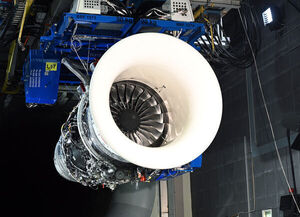
Rolls-Royce conducts first tests of 100% sustainable aviation fuel for use in business jets
"Rolls-Royce has conducted the first tests of 100% Sustainable Aviation Fuel (SAF) in a business jet engine, as part of our ongoing ambition to play a leading role in enabling the sectors in which we operate reach net zero carbon by 2050. The tests on our latest business aviation engine in development, the Pearl 700, in Dahlewitz, Germany, come just weeks after unblended SAF was successfully used for the first time in engine ground tests on a Trent 1000 engine in Derby, UK. This test demonstrates once again that our current engines for large civil and business jet applications can operate with 100% SAF as a full “drop-in” option, laying the groundwork for moving this type of fuel towards certification. At present, SAF is only certified for blends of up to 50% with conventional jet fuel and can be used on all current Rolls-Royce engines. The SAF that was used in the tests was produced by low-carbon fuel specialist World Energy in Paramount, California, sourced by Shell Aviation and delivered by SkyNRG. This unblended fuel has the potential to reduce net CO2 lifecycle emissions by more than 75% compared to conventional jet fuel, with the possibility of further reductions in future." [...]
Ciência e Tecnologia
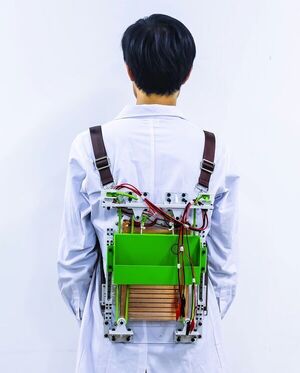
Load-reducing backpack powers electronics by harvesting energy from walking
"Hikers, soldiers and school children all know the burden of a heavy backpack. But now, researchers have developed a prototype that not only makes loads feel about 20% lighter, but also harvests energy from human movements to power small electronics. The new backpack, reported in ACS Nano, could be especially useful for athletes, explorers and disaster rescuers who work in remote areas without electricity, the researchers say. Backpacks are widely used in everyday life for the hands-free carrying of loads. Over time, however, walking or running with a heavy sack can cause back and neck pain. Also, backpackers in wilderness areas (or even those in cities who don’t have ready access to a charger) might wish for a bag that could harvest the mechanical energy of walking to power portable electronics or health-monitoring sensors." [...]

Scientists use trilayer graphene configuration to observe more robust superconductivity
"In 2018, the physics world was set ablaze with the discovery that when an ultrathin layer of carbon, called graphene, is stacked and twisted to a “magic angle,” that new double-layered structure converts into a superconductor, allowing electricity to flow without resistance or energy waste. Now, in a literal twist, Harvard scientists have expanded on that by adding a third layer and rotating it, opening the door for continued advancements in graphene-based superconductivity. The work is described in a new paper in Science, and eventually could lead toward superconductors that operate at higher temperatures — even close to room temperature. These superconductors are considered the Holy Grail of condensed-matter physics, as they would open the door to tremendous technological revolutions in many areas, including electricity transmission, transportation, and quantum computing. Most superconductors today, including the double-layered graphene system, work only at ultracold temperatures. “Superconductivity in twisted graphene provides physicists with an experimentally controllable and theoretically accessible model system where they can play with the system’s properties to decode the secrets of high-temperature superconductivity,” said one of the paper’s co-lead authors, Andrew Zimmerman, a postdoctoral researcher working in the lab of Harvard physicist Philip Kim." [...]

Fine tuned: adjusting the composition and properties of semiconducting 2D alloys
"Scientists experimentally realize 2D Si-Ge alloys with tunable electronic properties, getting us closer to a breakthrough in modern electronics Semiconducting 2D alloys could be key to overcoming the technical limitations of modern electronics. Although 2D Si-Ge alloys would have interesting properties for this purpose, they were only predicted theoretically. Now, scientists from Japan Advanced Institute of Science and Technology have realized the first experimental demonstration. They have also shown that the Si to Ge ratio can be adjusted to fine tune the electronic properties of the alloys, paving the way for novel applications. Alloys--materials composed of a combination of different elements or compounds--have played a crucial role in the technological development of humans since the Bronze Age. Today, alloying materials with similar structures and compatible elements is essential because it enables us to fine tune the properties of the final alloy to match our needs." [...]

Quantum Computing Scientists Call for Ethical Guidelines
"A group of quantum computing experts, including scientists and company executives, want to raise ethical concerns about the technology’s potential to create new materials for war and accelerate human DNA manipulation. Six experts are featured in a 13-minute video titled “Quantum Ethics: A Call to Action,” which goes live Monday on YouTube and the Quantum Daily, a free online source for quantum computing news. The goal of the video, which features a former quantum chief at Alphabet Inc.’s Google, is to kick off conversations with other quantum computing industry leaders about the ethical implications of the technology. “Whenever we have a new computing power, there is potential for benefit of humanity, [but] you can imagine ways that it would also hurt people,” said John Martinis, professor of physics at University of California, Santa Barbara, and former chief scientist of quantum hardware at Google. While quantum computers are still in their early stages, it is important to begin discussing the potential benefits and drawbacks of the technology and find a way to balance the two, he said. “You want to think ahead,” he said." [...]
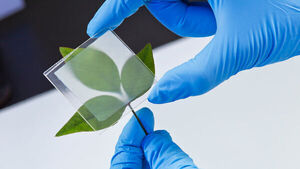
Where Wood Gets Weird
"What’s bouncy, bulletproof, cools you in the summer, keeps you toasty warm in winter and might help save our planet? The answer literally grows on (and in) trees: wood—at least in the many unfamiliar guises it takes on in the lab of materials science and engineering Professor Liangbing “Bing” Hu, director of the Center for Materials Innovation at UMD. Hu is an expert in nanomaterials, which generally are manufactured to have special characteristics—like ultrastrength or superconductivity—based on their microscopic structure. Hu got excited several years ago when he realized there was an almost infinite supply of natural nanomaterial that’s both versatile and strong, and buried in the grain structure of wood. Since then, he’s been developing different methods to access and exploit that hidden resource while developing surprising new applications that a UMD spinoff company, InventWood, is readying for market. “Sustainability and environmental protection convinced me more and more to pursue this,” he says." [...]

New process can extend lifetime of metals
"Western materials engineer Hamid Abdolvand and his team discovered important factors into the deformation of metals used in automobiles and nuclear reactors, and developed new models to predict the lifetimes of these materials. Stronger, lighter, cheaper materials are the name of the game in advanced manufacturing. Keeping costs down on materials that are equally, if not more, effective than previous ones is how businesses get ahead – and, theoretically, when consumers win. But what if stronger, lighter and cheaper means shorter lifetimes for materials used in automobiles? That’s the problem an international research team led by Western materials engineer Hamidreza Abdolvand tackled in a new study published by high-impact journals Acta Materialia and Communications Materials. Abdolvand, along with Western Engineering graduate student Karim Louca and collaborators at the European Synchrotron Radiation Facility and Arts et Métiers ParisTech, discovered important factors contributing to the deformation (changing shape) of metals used in automobiles and nuclear reactors, and developed new models to predict the lifetimes of these materials." [...]

New piezoelectric material remains effective to high temperatures
"Piezoelectric materials hold great promise as sensors and as energy harvesters but are normally much less effective at high temperatures, limiting their use in environments such as engines or space exploration. However, a new piezoelectric device developed by a team of researchers from Penn State and QorTek remains highly effective at elevated temperatures. Clive Randall, director of Penn State’s Materials Research Institute (MRI), developed the material and device in partnership with researchers from QorTek, a State College, Pennsylvania-based company specializing in smart material devices and high-density power electronics. “NASA’s need was how to power electronics in remote locations where batteries are difficult to access for changing,” Randall said. “They also wanted self-powering sensors that monitor systems such as engine stabilities and have these devices work during rocket launches and other high-temperature situations where current piezoelectrics fail due to the heat.” Piezoelectric materials generate an electric charge when rapidly compressed by a mechanical force during vibrations or motion, such as from machinery or an engine. This can serve as a sensor to measure changes in pressure, temperature, strain or acceleration." [...]

‘Defective’ carbon simplifies hydrogen peroxide production
"Plasma processing modifies carbon black powder to catalyze valuable chemical Rice University researchers have created a “defective” catalyst that simplifies the generation of hydrogen peroxide from oxygen. Rice scientists treated metal-free carbon black, the inexpensive, powdered product of petroleum production, with oxygen plasma. The process introduces defects and oxygen-containing groups into the structure of the carbon particles, exposing more surface area for interactions. When used as a catalyst, the defective particles known as CB-Plasma reduce oxygen to hydrogen peroxide with 100% Faradaic efficiency, a measure of charge transfer in electrochemical reactions. The process shows promise to replace the complex anthraquinone-based production method that requires expensive catalysts and generates toxic organic byproducts and large amounts of wastewater, according to the researchers. The research by Rice chemist James Tour and materials theorist Boris Yakobson appears in the American Chemical Society journal ACS Catalysis." [...]

How the 3-D structure of eye-lens proteins is formed
"Chemical bonds within the eye-lens protein gamma-B crystallin hold the protein together and are therefore important for the function of the protein within the lens. Contrary to previous assumptions, some of these bonds, called disulphide bridges, are already formed simultaneously with the synthesis of the protein in the cell. This is what scientists at Goethe University Frankfurt, Max Planck Institute of Biophysics and the French Institute de Biologie Structurale in Grenoble have discovered. The lens of the human eye gets its transparency and refractive power from the fact that certain proteins are densely packed in its cells. These are mainly crystallines. If this dense packing cannot be maintained, for example due to hereditary changes in the crystallines, the result is lens opacities, known as cataracts, which are the most common cause of vision loss worldwide." [...]
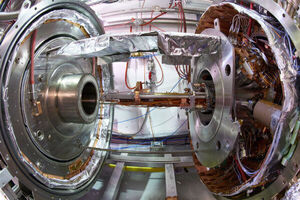
AEgIS on track to test free-fall of antimatter
"The AEgIS collaboration at CERN’s Antiproton Decelerator (AD) has reported a milestone in its bid to measure the gravitational free-fall of antimatter – a fundamental test of the weak equivalence principle. Using a series of techniques developed in 2018, the team demonstrated the first pulsed production of antihydrogen, which allows the time at which the antiatoms are formed to be known with high accuracy. This is a key step in determining “g” for antimatter. “This is the first time that pulsed formation of antihydrogen has been established on timescales that open the door to simultaneous manipulation, by lasers or external fields, of the formed atoms, as well as to the possibility of applying the same method to pulsed formation of other antiprotonic atoms,” says AEgIS spokesperson Michael Doser of CERN. “Knowing the moment of antihydrogen formation is a powerful tool.” General relativity’s weak equivalence principle holds that all particles with the same initial position and velocity should follow the same trajectories in a gravitational field. It has been verified for matter with an accuracy approaching 10–14." [...]
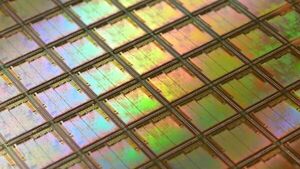
Wafer-scale production of graphene-based photonic devices
"Our world needs reliable telecommunications more than ever before. However, classic devices have limitations in terms of size and cost and, especially, power consumption – which is directly related to greenhouse emissions. Graphene could change this and transform the future of broadband. Now, Graphene Flagship researchers have devised a wafer-scale fabrication technology that, thanks to predetermined graphene single-crystal templates, allows for integration into silicon wafers, enabling automation and paving the way to large scale production. This work, published in the prestigious journal ACS Nano, is a great example of a collaboration fostered by the Graphene Flagship ecosystem. It counted on the participation of several Graphene Flagship partner institutions like CNIT and the Istituto Italiano di Tecnologia (IIT), in Italy, the Cambridge Graphene Centre at the University of Cambridge, UK, and Graphene Flagship Associated Member and spin-off CamGraphIC." [...]
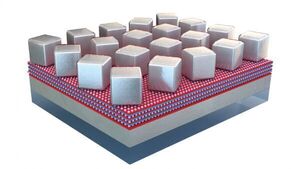
Capturing Free-Space Optical Light for High-Speed WiFi
"Plasmonic speed enhancements previously constrained to nanoscale phenomena are replicated on macroscopic devices Visible and infrared light can carry more data than radio waves, but has always been confined to a hard-wired, fiber-optic cable. Working with Facebook’s Connectivity Lab, a Duke research team has now made a major advance toward the dream of ditching the fiber in fiber optics. While working to create a free-space optical communication system for high-speed wireless internet, the researchers also show that speed and efficiency properties previously demonstrated on tiny, single-unit plasmonic antennas can also be achieved on larger, centimeter-scale devices. The research appears online Feb. 11 in the journal Optica. In 2016, researchers from Internet.org’s Connectivity Lab—a subsidiary of Facebook—outlined a new type of light detector that could potentially be used for free-space optical communication. Traditionally, hard-wired optical fiber connections can be much faster than radio wave wireless connections." [...]
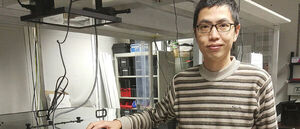
Vibrating 2D Materials
"Two-dimensional materials hold out hope for many technical applications. An international research team now has determined for the first time how strongly 2D materials vibrate when electronically excited with light. Current electronic components in computers, mobile phones and many other devices are based on microstructured silicon carriers. However, this technology has almost reached its physical limits and the smallest possible structure sizes. Two-dimensional (2D) materials are therefore being intensively researched. One can imagine these materials as extremely thin films consisting of only one layer of atoms." [...]
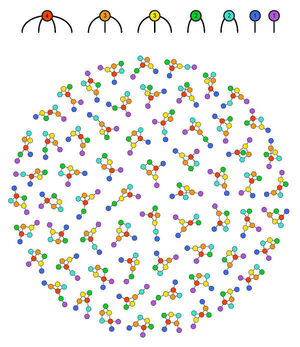
Really random networks - New mathematical method for generating random connected networks
"Many natural and man-made networks, such as computer, biological or social networks have a connectivity structure that critically shapes their behavior. The academic field of network science is concerned with analyzing such real-world complex networks and understanding how their structure influences their function or behavior. Examples are the vascular network of our bodies, the network of neurons in our brain, or the network of how an epidemic is spreading through a society. The need for reliable null models The analysis of such networks often focuses on finding interesting properties and features. For example, does the structure of a particular contact network help diseases spread especially quickly? In order to find out, we need a baseline—a set of random networks, a so-called “null model”—to compare to." [...]
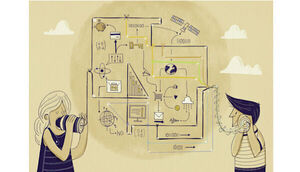
Quantum effects help minimise communication flaws
"Noise limits the performance of modern quantum technologies. However, particles traveling in a superposition of paths can bypass noise in communication. A collaboration between the Universities of Hong-Kong, Grenoble and Vienna, as well as the Austrian Academy of Sciences, under the lead of Philip Walther, reveals novel techniques to reduce noise in quantum communication. The results, published in the latest issue of "Physical Review Research", demonstrate that quantum particles traveling in a superposition of paths enable noise reduction in communications. Among the most active fields of research in modern physics, both at an academic level and beyond, are quantum computation and communication, which apply quantum phenomena such as superposition and entanglement to perform calculations, or to exchange information. A number of research groups around the world have built quantum devices that are able to perform calculations faster than any classical computer." [...]

SwRI Scientist proposes a new timeline for Mars terrains
"A Southwest Research Institute scientist has updated Mars chronology models to find that terrains shaped by ancient water activity on the planet’s surface may be hundreds of millions of years older than previously thought. This new chronology for Mars, based on the latest dynamical models for the formation and evolution of the solar system, is particularly significant as the days count down until NASA’s Mars 2020 Perseverance rover lands on the Red Planet on February 18, 2021. Unlike on Earth, where terrains are commonly dated using natural radioactivity of rocks, scientists have largely constrained the chronology of Mars by counting impact craters on its surface. “The idea behind crater dating is not rocket science; the more craters, the older the surface,” says SwRI’s Dr. Simone Marchi, who published a paper about these findings in The Astronomical Journal. “But the devil is in the details. Craters form when asteroids and comets strike the surface." [...]

A language learning system that pays attention — more efficiently than ever before
"MIT researchers’ new hardware and software system streamlines state-of-the-art sentence analysis. Human language can be inefficient. Some words are vital. Others, expendable. Reread the first sentence of this story. Just two words, “language” and “inefficient,” convey almost the entire meaning of the sentence." [...]

Forests of the world in 3D
"Research team led by the University of Göttingen analyses complexity of forest structure Primeval forests are of great importance for biodiversity and global carbon and water cycling. The three-dimensional structure of forests plays an important role here because it influences processes of gas and energy exchange with the atmosphere, whilst also providing habitats for numerous species. An international research team led by the University of Göttingen has investigated the variety of different complex structures that can be found in the world's forests, as well as the factors that explain this diversity. The results have been published in Nature Communications. The researchers investigated the structure of primeval forests on several continents in different climate zones. To achieve this, they spent two years travelling to remote primeval forest areas around the world to record the structure of the forests with the help of 3D laser scanners." [...]

2D Materials capable of forming complex 3D shapes
"University of Texas at Arlington researchers have developed a technique that programs 2D materials to transform into complex 3D shapes. The goal of the work is to create synthetic materials that can mimic how living organisms expand and contract soft tissues and thus achieve complex 3D movements and functions. Programming thin sheets, or 2D materials, to morph into 3D shapes can enable new technologies for soft robotics, deployable systems, and biomimetic manufacturing, which produces synthetic products that mimic biological processes. Kyungsuk Yum, an associate professor in the Materials Science and Engineering Department, and his team have developed the 2D material programming technique for 3D shaping. It allows the team to print 2D materials encoded with spatially controlled in-plane growth or contraction that can transform to programmed 3D structures. Their research, supported by a National Science Foundation Early Career Development Award that Yum received in 2019, was published in January in Nature Communications." [...]
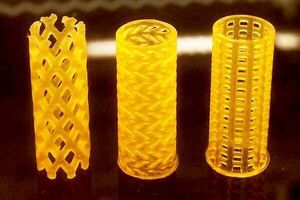
3D-printed bioresorbable airway stent
"An ETH Zurich research team is using 3D printing to produce a new type of bioresorbable airway stent. This could greatly simplify the future treatment of upper airway obstruction. Narrowing of the trachea or the main bronchi due to injury or illness can end very badly. If patients get too little oxygen, they risk suffocating and often need medical help as quickly as possible. Surgeons insert stents made of medically usable silicone or metal as a way of treating these patients. Although they quickly bring relief, the implants also have disadvantages: Metal stents have to be removed surgically with some effort, which is a burden for the patients, while silicone stents often migrate away from the insertion site." [...]
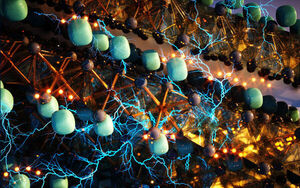
Supercomputers Advance Longer-Lasting, Faster-Charging Batteries
"Researchers at UC San Diego, other universities collectively advance battery technologies In an effort to curb the rise in overall carbon vehicle emissions, the state of California recently announced a plan to ban new sales of gasoline-powered vehicles in less than 15 years – if the current governor’s order holds strong. Now, thanks to supercomputers funded by the National Science Foundation such as Comet at the San Diego Supercomputer Center (SDSC) at UC San Diego and Stampede2 at the Texas Advanced Computing Center (TACC), the research community has been making progress on developing more reliable and efficient electric cars and light trucks as well as other products by focusing on the batteries that power them. Three such university teams that recently were given allocations on these supercomputers include researchers from UC San Diego, Washington University in Saint Louis, and Washington State University. “We have been working on making lithium-ion batteries longer lasting and faster charging for many years,” said Shyue Ping Ong, associate professor of nanoengineering at UC San Diego. “Comet was crucial for performing the calculations to elucidate the unique lithium insertion and diffusion mechanisms responsible for the high-rate capability in a new anode material we are developing.” This new Li3V2O5 anode, which is a safer alternative to the typical graphite anode found in today’s lithium-ion batteries, was the focus of Ong’s recent publication in the journal Nature. The study was co-authored by UC San Diego’s Sustainable Power and Energy Director Ping Liu, who explained that this new anode approach can be cycled for more than 6,000 times with negligible capacity decay, and can charge and discharge energy rapidly, delivering over 40 percent of its capacity in 20 seconds." [...]

Machine-learning to predict the performance of organic solar cells
"Researchers from Universitat Rovira i Virgili and Institute of Materials Science of Barcelona have combined experimental data with algorithms and enable an unprecedent predicting capability of the performance of organic solar cells Imagine looking for the optimal configuration to build an organic solar cell made from different polymers. How would you start? Does the active layer need to be very thick, or very thin? Does it need a large or a small amount of each polymer? Knowing how to predict the specific composition and cell design that would result in optimum performance is one of the greatest unresolved problems in materials science. This is, in part, due to the fact that the device performance depends on multiple factors." [...]
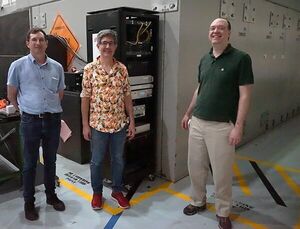
Neutrinos, atomic clocks and an experiment to detect a time dilation
"Griffith University researchers are conducting an experiment at ANSTO that will test a revolutionary physics theory that time reversal symmetry-breaking by neutrinos might cause a time dilation at the quantum scale. With support from the National Measurement Institute (NMI), A/Prof Erik Streed needed a source of anti-neutrinos and some atomic clocks to carry out a preliminary experiment that would test the validity of a new quantum theory of time being developed by his Griffith University colleague Professor Joan Vaccaro. A quantum theory of time Vaccaro is an accomplished theoretical physicist, who has developed a fundamental theory that puts time and space on the same footing. The theory proposes that the dynamics we observe everywhere as changes occurring over time are not fundamental parts of nature but emerge phenomenologically due to time symmetry violations. It is revolutionary because if it is correct, it will overturn the way we think about time and space, as well as fundamental laws, such as the conservation of mass. A source of neutrinos to test the theory Following the publication of the theory in 2016, Vaccaro proposed that an experiment could be undertaken with a nuclear reactor to test the theory." [...]

Radiative cooling and solar heating from one system, no electricity needed
"Passive cooling, like the shade a tree provides, has been around forever. Recently, researchers have been exploring how to turbo charge a passive cooling technique — known as radiative or sky cooling — with sun-blocking nanomaterials that emit heat away from building rooftops. While progress has been made, this eco-friendly technology isn’t commonplace because researchers have struggled to maximize its cooling capabilities. New research led by UB engineers makes significant progress in this area. A study published Feb. 8 in the journal Cell Reports Physical Science describes a uniquely designed radiative cooling system that: Lowered the temperature inside a test system in an outdoor environment under direct sunlight by more than 12 degrees Celsius (22 degrees Fahrenheit). Lowered the temperature of the test box in a laboratory, meant to simulate the night, by more than 14 degrees Celsius (25 degrees Fahrenheit)." [...]
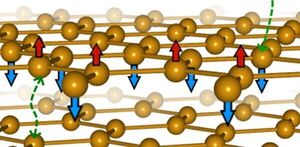
‘Magnetic graphene’ forms a new kind of magnetism
"Researchers have identified a new form of magnetism in so-called magnetic graphene, which could point the way toward understanding superconductivity in this unusual type of material. The researchers, led by the University of Cambridge, were able to control the conductivity and magnetism of iron thiophosphate (FePS3), a two-dimensional material which undergoes a transition from an insulator to a metal when compressed. This class of magnetic materials offers new routes to understanding the physics of new magnetic states and superconductivity. Using new high-pressure techniques, the researchers have shown what happens to magnetic graphene during the transition from insulator to conductor and into its unconventional metallic state, realised only under ultra-high pressure conditions. When the material becomes metallic, it remains magnetic, which is contrary to previous results and provides clues as to how the electrical conduction in the metallic phase works. The newly discovered high-pressure magnetic phase likely forms a precursor to superconductivity so understanding its mechanisms is vital." [...]
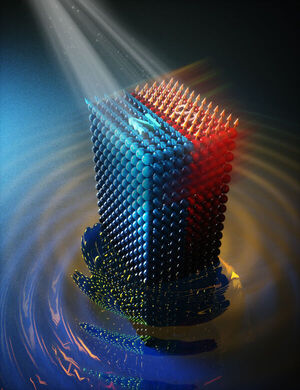
Researchers control a magnet’s state by optically shaking its atomic lattice
"An international team led by researchers of Delft University of Technology (TU Delft) has managed to manipulate the magnetic state of a magnetic material by optically shaking it. The whole process happens within an extremely short time frame of less than a few picoseconds. In times of stalling efficiency trends of current technology, such atomically-driven ultrafast control of magnetism opens broad new vistas for information technology. The results, which have been published in Nature Materials, could eventually lead to fast and energy-efficient data processing technologies, which are essential to keep up with our data hunger. According to Dick Tracy – famous comic strip hero who made his early debut in 1931 – the nation that controls magnetism will control the universe. One can argue that, today, this idea sounds a lot more believable than it did back then." [...]
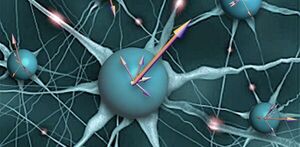
‘Multiplying’ light could be key to ultra-powerful optical computers
"New type of optical computing could solve highly complex problems that are out of reach for even the most powerful supercomputers. An important class of challenging computational problems, with applications in graph theory, neural networks, artificial intelligence and error-correcting codes can be solved by multiplying light signals, according to researchers from the University of Cambridge and Skolkovo Institute of Science and Technology in Russia. In a paper published in the journal Physical Review Letters, they propose a new type of computation that could revolutionise analogue computing by dramatically reducing the number of light signals needed while simplifying the search for the best mathematical solutions, allowing for ultra-fast optical computers. Optical or photonic computing uses photons produced by lasers or diodes for computation, as opposed to classical computers which use electrons. Since photons are essentially without mass and can travel faster than electrons, an optical computer would be superfast, energy-efficient and able to process information simultaneously through multiple temporal or spatial optical channels. The computing element in an optical computer – an alternative to the ones and zeroes of a digital computer – is represented by the continuous phase of the light signal, and the computation is normally achieved by adding two light waves coming from two different sources and then projecting the result onto ‘0’ or ‘1’ states." [...]

Fabricating fully functional drones
"CSAIL's “LaserFactory” system automates the full process for making functional devices in one system. From Star Trek’s replicators to Richie Rich’s wishing machine, popular culture has a long history of parading flashy machines that can instantly output any item to a user’s delight. While 3D printers have now made it possible to produce a range of objects that include product models, jewelry, and novelty toys, we still lack the ability to fabricate more complex devices that are essentially ready-to-go right out of the printer. A group from MIT’s Computer Science and Artificial Intelligence Laboratory (CSAIL) recently developed a new system to print functional, custom-made devices and robots, without human intervention. Their single system uses a three-ingredient recipe that lets users create structural geometry, print traces, and assemble electronic components like sensors and actuators. “LaserFactory” has two parts that work in harmony: a software toolkit that allows users to design custom devices, and a hardware platform that fabricates them." [...]
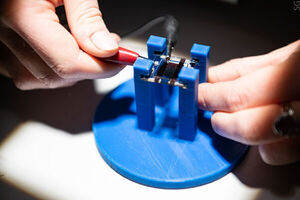
A New Modifier Increases the Efficiency of Perovskite Solar Cells
"The research team of NUST MISIS has presented an improved structure of perovskite solar cells. Scientists have modified perovskite-based solar cells using MXenes — thin two-dimensional titanium carbides with high electrical conductivity. The MXenes-based modified cells showed superior performance, with power conversion efficiency exceeding 19% (the reference demonstrated 17%) and improved stabilized power output with respect to reference devices. The results have been published in the Nano energy international scientific journal. Perovskite solar cells are promising alternative energy technology worldwide. They can be printed on special inkjet or slot die printers with minimal quantity of vacuum processes." [...]

Quantum computing enables simulations to unravel mysteries of magnetic materials
"A multi-institutional team became the first to generate accurate results from materials science simulations on a quantum computer that can be verified with neutron scattering experiments and other practical techniques. Researchers from the Department of Energy’s Oak Ridge National Laboratory; the University of Tennessee, Knoxville; Purdue University and D-Wave Systems harnessed the power of quantum annealing, a form of quantum computing, by embedding an existing model into a quantum computer. Characterizing materials has long been a hallmark of classical supercomputers, which encode information using a binary system of bits that are each assigned a value of either 0 or 1. But quantum computers — in this case, D-Wave’s 2000Q – rely on qubits, which can be valued at 0, 1 or both simultaneously because of a quantum mechanical capability known as superposition. “The underlying method behind solving materials science problems on quantum computers had already been developed, but it was all theoretical,” said Paul Kairys, a student at UT Knoxville’s Bredesen Center for Interdisciplinary Research and Graduate Education who led ORNL’s contributions to the project. “We developed new solutions to enable materials simulations on real-world quantum devices.” This unique approach proved that quantum resources are capable of studying the magnetic structure and properties of these materials, which could lead to a better understanding of spin liquids, spin ices and other novel phases of matter useful for data storage and spintronics applications." [...]
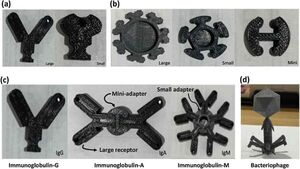
The proof is in writing
"NYU Tandon SOAR fellows publish a paper on the efficacy of their methods “While Science, Technology, Engineering, and Mathematics (STEM) education is essential in the high school curriculum, it often carries a reputation of being formidable and overwhelming,” Julia Monkovic, a senior majoring in Chemical and Biomolecular Engineering, says. She hoped to help remedy that as an NYU Tandon Science Outreach and Research (SOAR) fellow. The fellowship initiative was spearheaded by Professor of Chemical and Biomolecular Engineering Jin Montclare and is aimed at inspiring the next generation of engineers, chemists, and coders by sending select Tandon students into high school science classrooms and labs to serve as instructors and mentors. Monkovic took part as a sophomore and junior, working with ninth-graders from Brooklyn’s Urban Assembly Institute for Math and Science for Young Women, where she taught a unit on homeostasis and immunity. “Conventional teaching methods of recent decades are heavily based on textbooks and lectures, often referred to as ‘frontal teaching,’ or ‘chalk-and-talk,’” she explained. “But students have a strong inclination towards technology-enabled learning, and our educational system must change with them.” To that end, she created 3D-printed models of several antigens and the antibodies that fight them, allowing students to connect them to represent the binding that occurs as the body fights off a pathogen." [...]
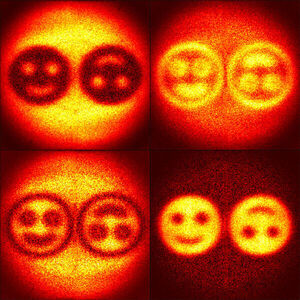
Holography ‘Quantum Leap’ Could Revolutionise Imaging
"A new type of quantum holography which uses entangled photons to overcome the limitations of conventional holographic approaches could lead to improved medical imaging and speed the advance of quantum information science. A team of physicists from the University of Glasgow are the first in the world to find a way to use quantum-entangled photons to encode information in a hologram. The process behind their breakthrough is outlined in a paper published today (Thursday 4 February) in the journal Nature Physics. Holography is familiar to many from its use as security images printed on credit cards and passports, but it has many other practical applications, including data storage, medical imaging and defence. Classical holography creates two-dimensional renderings of three-dimensional objects with a beam of laser light split into two paths. The path of one beam, known as the object beam, illuminates the holograph’s subject, with the reflected light collected by a camera or special holographic film." [...]

Insights into Lithium Metal Battery Failure Open Doors to Doubling Battery Life
"Lithium metal batteries could double the amount of energy held by lithium-ion batteries, if only their anodes didn't break down into small pieces when they were used. Now, researchers led by Prof. CUI Guanglei from the Qingdao Institute of Bioenergy and Bioprocess Technology (QIBEBT) of the Chinese Academy of Sciences (CAS) have identified what causes lithium metal batteries (LMBs) to "self-destruct" and proposed a way to prevent it. The findings were published in Angewandte Chemie on Jan. 19. This offers hope of radically enhancing the energy held in batteries without any increase in their size, and at reduced cost. In fact, LMBs were the original concept for long-lasting batteries, but their anodes break down into small pieces - a microstructure known as "pulverization". The LMBs thus quickly stop working when being cycled through." [...]

Chiral Lead-free Hybrid Perovskites Developed for Self-powered Circularly Polarized Light Detection
"The metal-halide perovskites feature the distinctive structure flexibility, which enables the employment of chiral organic cations to construct chiral perovskites. Such chiral perovskites are the promising alternative for circular polarized light (CPL) detection owing to their efficient charge transport of inorganic frameworks and CPL-sensitive property induced by chiral organics. In a study published in Angew. Chem. In. Ed., the research group led by Prof. LUO Junhua from Fujian Institute of Research on the Structure of Matter (FJIRSM) of the Chinese Academy of Sciences (CAS) reported two chiral lead-free hybrid perovskites." [...]
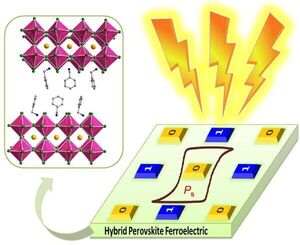
Fatigue-free Layered Hybrid Perovskite Ferroelectric Developed for Photovoltaic Non-volatile Memories
"Ferroelectric materials with reversible spontaneous polarization have been extensively investigated as active media for non-volatile memories. However, most of the ferroelectric materials known suffer from high internal resistances, large bandgap, and poor carrier transportation, which hindered their further applications. The family of hybrid perovskite ferroelectrics combining polarization and semiconducting properties presents itself as a promising alternative. Particularly, taking the excellent semiconducting and fatigue-free potential into consideration, the researchers could expect that the layered hybrid perovskite ferroelectrics could reformate the field of photovoltaic non-volatile memories. In a study published in Angew. Chem." [...]
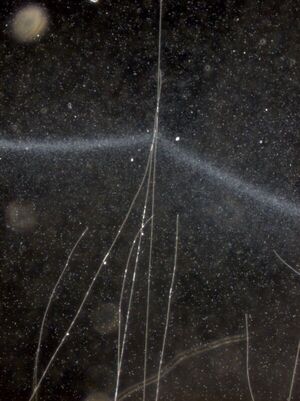
Electric cable bacteria breathe oxygen with unheard efficiency
"Ten years ago, researchers at Aarhus University, Denmark, reported the discovery of centimeter-long cable bacteria, that live by conducting an electric current from one end to the other. Now the researchers document that a few cells operate with extremely high oxygen consumption while the rest of the cells process food and grow without oxygen. An outstanding way of life. We humans need food and oxygen to live. Now, imagine if oxygen was to be found only at the mountain top and food only in the valley. That’s how the world looks like for cable bacteria, which live in the bottom of seas and lakes." [...]
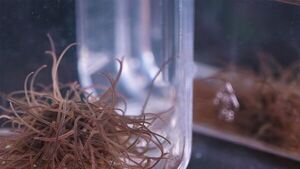
Collective Worm and Robot “Blobs” Protect Individuals, Swarm Together
"Individually, California blackworms live an unremarkable life eating microorganisms in ponds and serving as tropical fish food for aquarium enthusiasts. But together, tens, hundreds, or thousands of the centimeter-long creatures can collaborate to form a “worm blob,” a shape-shifting living liquid that collectively protects its members from drying out and helps them escape threats such as excessive heat. While other organisms form collective flocks, schools, or swarms for such purposes as mating, predation, and protection, the Lumbriculus variegatus worms are unusual in their ability to braid themselves together to accomplish tasks that unconnected individuals cannot. A new study reported by researchers at the Georgia Institute of Technology describes how the worms self-organize to act as entangled “active matter,” creating surprising collective behaviors whose principles have been applied to help blobs of simple robots evolve their own locomotion. The research, supported by the National Science Foundation and the Army Research Office, was reported Feb. 5 in the journal Proceedings of the National Academy of Sciences. Findings from the work could help developers of swarm robots understand how emergent behavior of entangled active matter can produce unexpected, complex, and potentially useful mechanically driven behaviors." [...]

UMass Amherst Team Helps Demonstrate Spontaneous Quantum Error Correction
"New research tackles a central challenge of powerful quantum computing To build a universal quantum computer from fragile quantum components, effective implementation of quantum error correction (QEC) is an essential requirement and a central challenge. QEC is used in quantum computing, which has the potential to solve scientific problems beyond the scope of supercomputers, to protect quantum information from errors due to various noise. Published by the journal Nature, research co-authored by University of Massachusetts Amherst physicist Chen Wang, graduate students Jeffrey Gertler and Shruti Shirol, and postdoctoral researcher Juliang Li takes a step toward building a fault-tolerant quantum computer. They have realized a novel type of QEC where the quantum errors are spontaneously corrected. Today’s computers are built with transistors representing classical bits (0’s or 1’s). Quantum computing is an exciting new paradigm of computation using quantum bits (qubits) where quantum superposition can be exploited for exponential gains in processing power." [...]
Documentação
A documentação é parte essencial do processo de aprendizagem e a Internet além de artigos interessantes de explorar também tem alguma documentação em formato PDF interessante de ler. Todos os links aqui apresentados são para conteúdo disponibilizado livremente pelo editor do livro.

newelectronics 9 Fevereriro 2021
"New Electronics is a fortnightly magazine focusing on technological innovation, news and the latest developments in the electronics sector. Downloadable as a digital page turner or pdf file, or offered as a hard copy, the New Electronics magazine is available in a format to suit you. " [...]
Projetos Maker
Diversos Projetos interessantes.
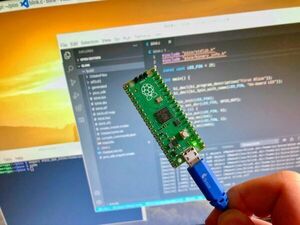
How to blink an LED with Raspberry Pi Pico in C
"The new Raspberry Pi Pico is very different from a traditional Raspberry Pi. Pico is a microcontroller, rather than a microcomputer. Unlike a Raspberry Pi it’s a platform you develop for, not a platform you develop on. But you still have choices if you want to develop for Pico, because there is both a C/C++ SDK and an official MicroPython port. Beyond that there are other options opening up, with a port of CircuitPython from Adafruit and the prospect of Arduino support, or even a Rust port. Here I’m going to talk about how to get started with the C/C++ SDK, which lets you develop for Raspberry Pi Pico from your laptop or Raspberry Pi." [...]

Bluetooth trackball Mark II
"I made a Bluetooth trackball in which all the electronics are inside the ball. The ball is the entire trackball. Here it is in action: Inside the ball there's a microcontroller and a set of sensors that together with some clever algorithms allow the microcontroller to know the ball's absolute orientation in 3D. When the ball is rotated, it sends the appropriate commands to the computer over Bluetooth to move the mouse cursor. Oh, and the keyboard in the video is a completely separate USB device, it's only used for mouse clicks and doesn't interact with the ball in any way. This is actually the second iteration of the project." [...]
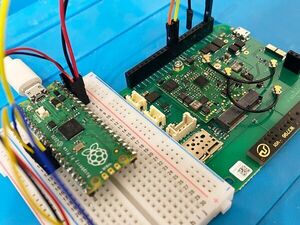
Adding Cellular to the Raspberry Pi Pico
"Learn how to add a Cellular IoT device to the Raspberry Pi Pico. I, like most of the maker world, was caught totally by surprise last week when the Raspberry Pi team announced their first microcontroller, the Pico. A custom, dual core, M0+ for 4 bucks? Sign me up! I got my Pico this week and it's an impressive little device with lots of GPIOs, peripherals, and support for both C and MicroPython. And since the Notecard Python library supports MicroPython, CircuitPython and Python out of the box, I figured I'd wire up the Notecard and show off how you can use the two to add cellular connectivity to your Pico projects." [...]

The "do not be alarmed" clock
"It’s a brand new year, which means I should really start writing a new post. I’ve been wanting to for a while, but we’ve been in lockdown for two months now and Google Analytics is the only indication that I’m not alone on the planet, and most of that is bots anyway. I’ve decided to take a page out of the book of my friend, James Stanley, who both does cool things and actually writes about them, so I’m starting to document all my projects again. Given my non-frenetic, slow-paced lifestyle, I’ve long had a non-burning need. I don’t use an alarm to wake up, as I start work late, but I still want to know what time it is when I wake up, just to see if it’s way too early and I can go to sleep again. A few days a week I have tennis and need to get up early, but if it’s windy or rainy or very cold, the practice gets canceled and I want to know before I’m awake enough to not be able to go to sleep again." [...]
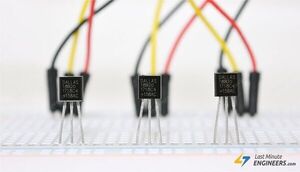
Interfacing Multiple DS18B20 Digital Temperature Sensors with Arduino
"One of the biggest advantages of DS18B20 is that multiple DS18B20 can coexist on the same 1-Wire bus. As each DS18B20 has a unique 64-bit serial code burned in at the factory, it’s easier to differentiate them from one another. The following tutorial demonstrates how to interface multiple DS18B20 on a single bus & get temperature readings from each of them. This feature can be a huge advantage when you want to control many DS18B20s distributed over a large area. It may look intimidating, but you should be familiar with basics of DS18B20 one-wire temperature sensor, before venturing further into this tutorial. Consider reading through below tutorial first." [...]

Smart altenative switch with ESP8266, ioBroker and MQTT
"We can make the lighting switches in our house smarter with this ESP8266 circuit, so if no WiFi it will continue to work as a normal switch. We can make the lighting switches in our house smarter with this ESP8266 circuit, so if something goes wrong (e.g. if there is no WiFi or the server is down) it will continue to work as a normal switch. You can find the original writing here: Smart Alternative Switch with ESP8266 for ioBroker via MQTT Attention! Parts of the following circuit work with Mains voltage. Mains voltage is not a toy, it can cause fatal electric shock or fire!" [...]

Make WiFi sensors and integrate with Node-RED on RPi
"Make in minutes a battery powered WiFi temperature sensor with GUI dashboard in Node-RED on Raspberry Pi! In this project we show how to build battery powered WiFi sensors (i.e. temperature), buttons or any other IOT end nodes with Cricket and integrate them, without writing any code or programming to Node-RED. We use Raspberry Pi to host Node-RED in our local network. This project can be realised by makers at all skill levels. It may require some basic soldering however it doesn't require any coding or programming." [...]

Build seven segment LED digit called “pxlDigit” from WS2812 LEDs
"For another project I urgently needed a relatively large number to indicate a duration. From this this small “sub-project” emerged. Because with the 3D printed frame described here and a couple of WS2812 LEDs you can easily build a seven-segment number (or several) and use it to build displays to show numbers. Over time, I noticed that these types of digits are suitable for all kinds of projects. For example, I’ve already used it to build a clock. Maybe you also have a new use for it." [...]

Realtime Heartrate Monitoring Using AVR-IoT and Firebase
"Measure heartrate realtime and show the data to platform. Brief: This page explains how to measure hearbeat realtime, and showing the result on Firebase platform. This project using minimal resource & effort to applied, and easier path to built. As always, this project is beginner friendly and easier to catch. 1. Hardware & Software Preparation We need to prepare those mentioned hardware above, those are: AVR IoT WG, Hearbeat sensor MAX30100, and micro usb cable." [...]
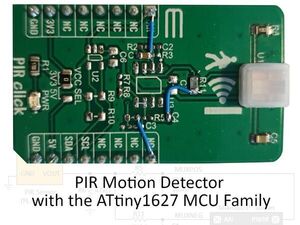
PIR Motion Sensing with the ATtiny1627 MCU Family
"Sense motion and environmental changes with a passive infrared sensor (PIR) on the ATtiny1627 MCU family. When I was in college, I was friends with one of the lab engineers that managed the electronics labs in the department. One of the problems that he worked on was to count students in a room in order to quantify lab usage over time. There are many approaches to this problem – visual cameras, radar sensors, door switches, etc… However, the solution would also have to be compliant with laws regarding privacy and be installable without damaging the lab space – this meant that some solutions, such as visual cameras, were almost immediately off the table. While he has since retired, the problem is still an interesting exercise. One possible way to solve this problem would be to use a Passive Infra-Red (PIR) Sensor." [...]
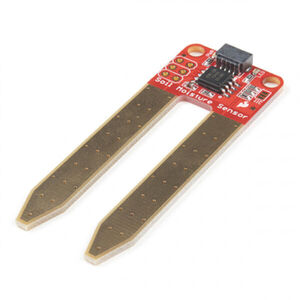
Soil Moisture Sensor Hookup Guide
"Have you ever wanted your plants to tell you when they need watered? Or know how saturated the soil in your garden is? With the SparkFun Soil Moisture Sensor, you can do just that! This tutorial will show you how to get started using the Soil Moisture Sensor as well as how to build your own soil moisture sensing project. If you prefer not to solder, you can purchase the sensor with a 3-pin screw terminal pre-soldered onto the board. " [...]
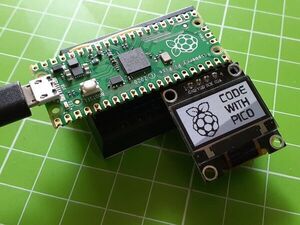
Getting Start with Raspberry Pi Pico
"Getting start with Raspberry Pi Pico and OLED Display Got couple of Raspberry pi pico boards last week. I was curious to try out some example on this pico board. Initially thought about coding with 'c' latest I decide to use micropython. This is going to be my 1st project with micropython. About Pico To know about the board details, you can find the spec here. some are - Dual-core Arm Cortex-M0+ processor, flexible clock running up to 133 MHz - 264KB on-chip SRAM - 2MB on-board QSPI Flash - 26 multifunction GPIO pins, including 3 analogue inputs - 2 × UART, 2 × SPI controllers, 2 × I2C controllers, 16 × PWM channels - Supported input power 1.8–5.5V DC - Temperature Sensor" [...]
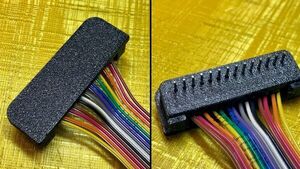
How to Create a Prototype Connector from a Pin Header
"In order to test the input panel, I had to connect the 14 lines to the test setup on a breadboard. Just using a pin header was too flimsy for me, because I often reuse these test connectors on different breadboards. In this short article, I explain how I made it into a solid connector. " [...]
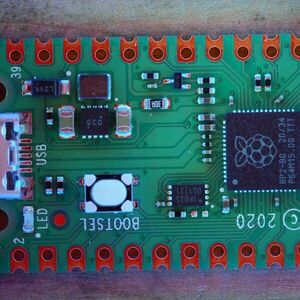
DIY AOI RGB Light
"Want a color-angular approach to inspecting your solder joint fillet quality? This rainbow-dome is your solution for less than $20! Hackaday covered some of the tools used for soldering inspection and I'm interested in photographing parts with this unique lighting setup, so let's print it! I've seen these go for about $1000, and that's just unacceptable, so I pulled this off with less than $10 of LED's and PLA filament. And labor. This model uses 5mm LED's, but I also built a version with NeoPixels which proved too tricky to solder together.I'm going to be building a 1m large version soon as well." [...]
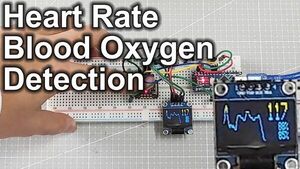
How to Make Heart Rate & Blood Oxygen Detection w/ MAX30102
"How to Make Heart Rate & Blood Oxygen Detection with MAX30102 Pulse Oximeter using Arduino In this project we only use the max30102 heart rate blood oxygen sensor module. Max30102 integrates a red LED and infrared LED, photodetector, optical device, and low-noise electronic circuit with ambient light suppression. In the project, when you measure your heart rate and blood oxygen concentration, press the button and your current heart rate and blood oxygen concentration will appear on the OLED screen. " [...]
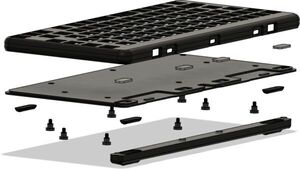
System76 Launch Configurable Keyboard
"The System76 Launch Configurable Keyboard is designed to provide the ultimate user controlled keyboard experience, with open source mechanical and electrical design, open source firmware and associated software, and a large number of user configuration opportunities. - Mechanical Design - Electrical Design - Firmware and Software" [...]
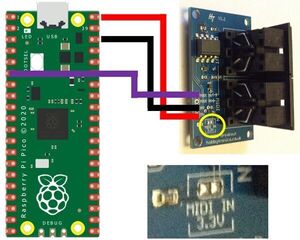
MIDI, MicroPython and the Raspberry Pi Pico
"It was an exciting day on Thursday this week on Twitter. I was able to watch the release of the Raspberry Pi Foundation’s new microcontroller board, the Raspberry Pi Pico and it looks like it will have lots of features that will be of interest for Simple DIY Electronic Music Projects. And the best bit? It already has a huge, supportive community to grow around it, extensive documentation, some really neat hardware features (thanks to it’s custom chip from the RPi people)., and you can buy one for just £3.60! In fact, if you subscribe to Hackspace Magazine (as I do) you get one for free with Issue 39. I’m not going to go over it in detail or “review” it, as you can essentially pick any of your regular online maker news sites and read about it there (here is a good start), but this is my MIDI “Hello World” as it were." [...]
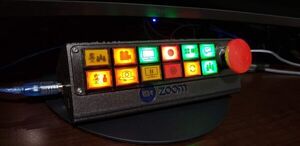
Zoom Control Panel
"A push-button control panel for Zoom This repo contains files for building a push-button control panel for Zoom. It was made using Windows short cuts, but could easily be modified for Mac instead. There are four major components to this build: - A 3D-printed case - Optional: Printing and installing button icons - Wiring buttons and Arduino Mega 2560 - Programming Arduino" [...]

Arduino Nipkow disk clock
"There is an old-fashioned type of Persistence-Of-View display called Nipkow disk display. I made a desk clock using that principle. My clock has an Arduino UNO heart and a olimex mod-RTC clock module to keep the time*. It features a nipkow disk with 10 holes placed in 5 rows so that each row is written twice per revolution. Hence, the disk produces a 40Hz picture when it spins at about 20rps.The clock has a blue top display and a red bottom display. Each display is comprised of 3 segments with 5 x 8 pixels." [...]
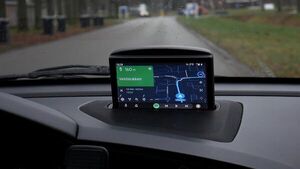
Android Auto on Volvo RTI
"This projects is a addon for my CAN bus extension project in order to add Android Auto functionality. The screen is displaying openauto on the stock Volvo RTI display using a Raspberry Pi and can be controlled using the stock steeringwheel buttons. When plugging in a phone using USB the display will automatically raise and start Android Auto. When the cable is removed or the ignition is switched off, the display will automatically turn off and lower. Components ESP32 CAN bus transceiver Raspberry Pi 3 Volvo RTI (Road Traffic Information) display 12v to 5v converter Relay X2 Apple USB C to 3.5 mm Audio 3.3 to 5V logic converter (Can be made using transistor and a few resistors) Power control and safe shutdown In a shutdown state my Raspberry Pi 3 still drew around ~250mA. The ESP32 therefore manages the power of the Pi." [...]
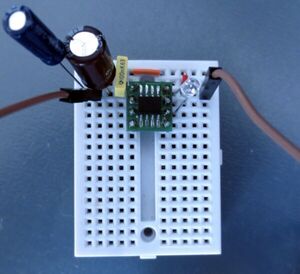
Ultra Low Power LED Flasher using the Padauk PFS154
"Flashing a LED is certainly among the first set of problems any burgeoning electronics specialist is tackling, may it be by using an ancient NE555 or, more recently, a microcontroller to control the LED. As it turns out, we can turn any trivial problem into a harder one by changing its constraints. So, what about the challenge of flashing a LED from the charge of a single battery as long as possible? Of course, also this is not a novel problem. Two interesting approaches that I came across in the past: 1) Burkhard Kainkas Ewiger Blinker (“Eternal Blinky”) and 2) Ted Yapos TritiLED. B. Kainkas project is a n LED flasher circuit made from discrete transistors that consumes about 50µA and is able to run for years from a single AA cell." [...]
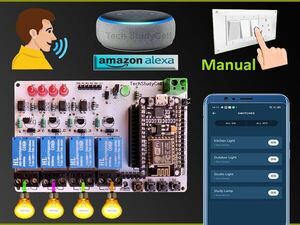
NodeMCU ESP8266 Alexa App Voice Control Smart Home System
"In this IoT project, I have shown how to make IoT based Smart Home Automation using Amazon Alexa & NodeMCU to control 4 home appliances. IoT based Smart Home Automation Using Amazon Alexa & NodeMCU to control 4 home appliances from the manual switch & Amazon Alexa App. If the internet is not available, then you can control the home appliances from manual switches. During the article, I have shown all the steps to make this smart home system. This NodeMCU Alexa control smart relay has the following features: 1. Control home appliances with voice commands using Alexa 2." [...]
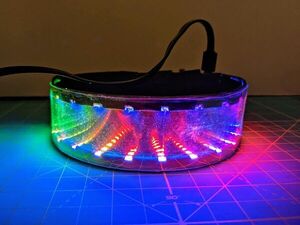
Infinity Mirror Collar
"An infinity mirror displays endless reproductions of whatever sits between its two reflective surfaces. This wearable design puts a twist on the typical infinity mirror project. By using holographic vinyl as the reflective material and EVA foam as a base, we are able to form the flexible materials into a circular collar, creating an appealing statement necklace. The two Side Light NeoPixel strips nestled between the vinyl layers produce colorful, dynamic patterns multiplied many times over in the resulting reflections. Controlled with CircuitPython code running on an ItsyBitsy nrf52840 Express, this unique wearable accessory lets you choose custom colors and animation patterns on the go with the Bluefruit phone app interface. " [...]

Moon Lamp With Remote
"Hello Everyone, I was inspired by https://www.instructables.com/Print-Your-Own-Moon/ and printed various sizes of the moon. They turned out good, but my challenges were Making it portable, rechargeable Work with and without wire Stronger Electronic circuit for the lamp Multi colors Easy service/troubleshooting Wooden stand Supplies: - 3d Printed Moon - Lithium battery from an old phone (width less than 28mm) - RGB LED strip - RGB controller with remote - TP4056 - lithium battery charger - MT3608- DC step-up convertor - 5.5x2.1mm power jack - Push-button - Wires - Soldering iron - Hot-glue - Multimeter - Scrap wooden plank - Jigsaw - PVA glue / fevicol - 13/64" dowels" [...]
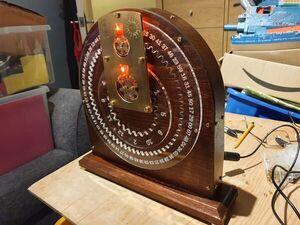
None sequential gear clock
"I was introduced to the idea of a none sequential clock by Bob at Hacman. The idea is two large gear rings with hours and minutes engraved on them driven by stepper motors. The numbers though, are out of sequence, and so each new minute and hour involves movement of the rings in a different direction and distance. I've always had a fascination with clocks, and I really liked the idea of this one. The rings are suspended from smaller gears which are directly attached to the steppers. It's a bit big though, probably 1.2m in diameter." [...]
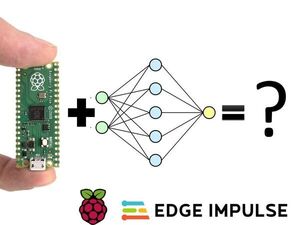
Machine Learning Inference on Raspberry Pico 2040
"Pen + pineapple = Pineapplepen. What about Pico + Machine Learning? This is another article in know-how series, which focuses solely on a specific feature or technique and today I’ll tell you how to use neural network trained with Edge Impulse with new Raspberry Pico 2040. Also make sure to watch the tutorial video with step-by-step instructions. " [...]
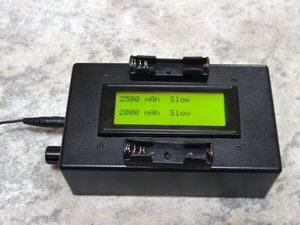
Dual NiMh battery charger
"Automatic charger for NiMh batteries built on Arduino. You can buy some battery charger in the near supermarket, but for sure it is better to create your very own charger and have fun. This charger can be used to slow and fast charge the batteries and also is allowing to restore your old batteries. The charger is based on Arduino micro controller, atmega328p-pu and displays whole usable information to the LCD character screen 16x2 or 20x4 one. It allows to charge up to two batteries independently. You can charge only one battery or charge two different capacity batteries or two similar batteries simultaneously." [...]
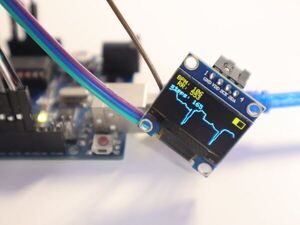
Getting Realtime ECG on OLED Screen
"I made an Arduino library allowing simple communication with uECG device using nRF24 module - minimal example takes just a few lines. Some time ago I posted a couple of projects demonstrating how to get data from uECG device - but they had quite a lot of messy code and still were using only basic data from it. So finally I wrote an Arduino library that makes this way simpler and much more reliable, here it is: https://github.com/ultimaterobotics/uECG_library (please note that you also need to install RF24 library from Library Manager, and if you want to show data on OLED like in this project - also Adafruit's SSD1306 library). 1. Schematics Schematics is the same as for any other project using nRF24 module and OLED: nRF24 is connected to Arduino's SPI bus (D13, D12, D11) and two arbitrary pins for module CS and CE lines - I've chosen D10 and D9 for convenience. The only important point: nRF24 module must be connected to 3.3V line, not to 5V!" [...]
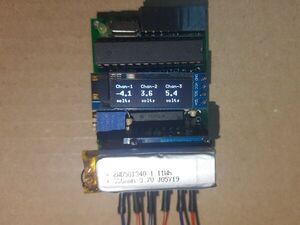
Arduino Negative Voltmeter
"3-channel voltmeter with the ability to measure both negative & positive voltages on the same circuit or 3 different circuits simultaneously Stuck with only one multimeter/voltmeter ? But, sometimes you need to check 2 or 3 voltages as the same time. Then this is something you might consider making, a real DC voltmeter ! Designed with commonly available components and easy to understand code, can measure both positive and negative voltages simultaneously on 3 nodes in a single circuit or 3 separate circuits. Hardware Following hardware are used to build this device:- - Arduino Uno: Uploading code on the ATmega328P microcontroller - ATmega328P: 8-bit micro with Arduino Bootloader and built-in 10 bit ADC - 128x32 1306 OLED Display with I2C interface: Display Voltages - LM324 OpAmp: Analog signal conditioning for ADC - 4cm x 6 cm FR4 protoboard: Circuit board for the build - 10k multiturn pot: Adjusting zero (half AREF) voltage - TP4056 module: LiPo battery charging - LiPo battery: 300mAh rechargable battery to power the device" [...]
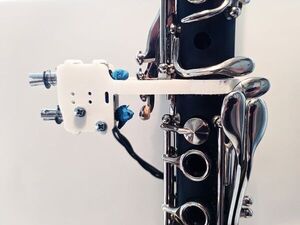
Motorizing a Bb clarinet
"Not enough fingers to play clarinet? With this project you can delegate solenoids to push two side-keys. Awkward fingerings whaaat? I am a quite amateurish clarinetist myself but I always liked to experiment with my instrument. Within this project I managed to add two robotic fingers which push two of the side-keys of the clarinet. Those keys are traditionally used for trills and for multiphonics, but their usage distracts the right hand of the performer from its common position." [...]
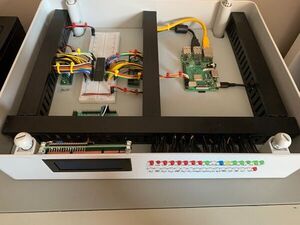
Raspberry Pi to Z80 interface
"Connect a Z80 CPU to your Raspberry Pi and run machine code on it! This project aims to create a Z80 to Raspberry Pi interface which will be used to map out and run use-case scenarios on the Z80 CPU. This will allow us compare real world results against subsequent emulation code. This document will describe the hardware, software and Python code required to interface directly with a Z80 CPU. An Intel 8080 compatible Z80 was chosen for its widespread adoption, excellent documentation and relatively simple 40-pin IO package. I will utilise a Raspberry Pi with multiple MCP23017 GPIO extenders to connect directly to the CPU and interact with it at the Logic level." [...]
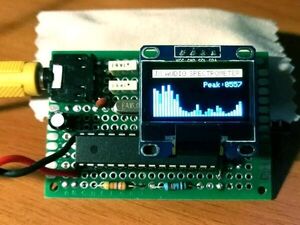
JX Audio Spectrometer
"A small gadget that uses an OLED display and the FFT library to generate the audio spectrum. Add a pinch of life to your music. Using any Arduino model and the ArduinoFFT library, a 0.96 inch two-color OLED display, you can make this nice spectrometer, an interesting alternative to the classic VU Meter. After trying it on a breadboard I made a stand alone prototype, burning an ATmega328 as clearly visible in the initial photo. The problem is being able to fit the code into the Arduino memory, since most of the ram is occupied by the display frame buffer. In this regard, I suggest you use an I2C SH1106 display." [...]
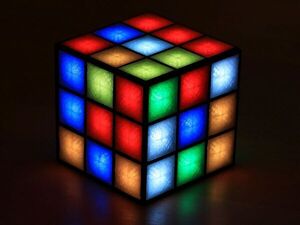
CyCubeTouch
"Reincarnation of Rubik's Cube as 3D-printed version with PSoC CapSense and WS2812B illumination. Most of you might have been still babies when Rubik's Cube was an amazing more than just a toy in the 1980s, and it's still popular, so for sure you might have seen the mechanical cube already somewhere. But now it's time to make a digital version of it! Touch and Light! Infineon + Cypress have great small microcontrollers, PSoC4, that allows each pin to be configured as touch input. Their CapSense(r) is really easy to use and allows a self-calibration or auto-tuning." [...]
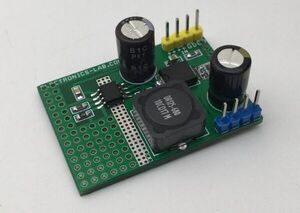
42V Input – 3.3V @ 2A Output High Voltage Step Down Regulator
"The project described here is a high voltage step-down regulator based on A4447 general-purpose buck converter chip from Allegro Semiconductor. The output voltage of the board is configured at 3.3V, but it is adjustable from 0.8 to 24V, based on the resistor divider R2 and R5. Connector CN1 is for DC input 24V-42V, Connector CN2 is DC Output. Refer to the information below to adjust various voltage outputs. Divider Resistor Value for 1.5V, 1.8V, 3.3V, 5V Output - 1.5V: R2=1.3K, R5=1.47K Ohms - 1.8V: R2=2.55K, R5=2K Ohms - 3.3V: R2= 3K, R5=910 Ohms - 5V: R2=6.34K, R5=1.2K Ohms The chip has a soft start feature, which allows the output to slowly ramp upon startup. This limits the maximum demand on the external power supply by controlling the inrush current required to charge the external capacitor and any DC load at start-up." [...]

BrowZen
"BrowZen correlates your emotional states with the web sites you visit to give you actionable insights about your time on the web. A webcam attached to an NVIDIA Jetson Xavier NX captures periodic images of the user of the computer as a background process. These images are classified (see classify_emotion.py) by a VGG19 convolutional neural network that has been pretrained to recognize seven emotional states ("Angry", "Disgust", "Fear", "Happy", "Sad", "Surprise", and "Neutral"). Observations (emotional state, datetime stamp) are recorded in an SQLite3 database. For privacy protection, images are destroyed after classification, and all processing takes place locally—nothing is sent to the cloud. Next, analysis.py connects to the SQLite3 database that stores web history in Chrome/Chromium and correlates web site visit times with the database of emotional state observations created by the classification step." [...]
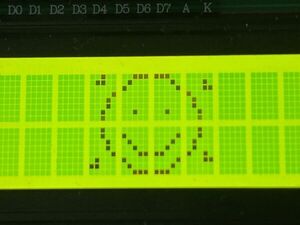
Create Custom Animations on 16x2 LCD Displays
"Easily display custom animated glyphs on 16x2 LCD using the createChar() function from the LiquidCrystal library. The LiquidCrystal library makes it easy to use LCDs with Arduino. A particularly interesting function from that library is the createChar() function: you can create custom glyphs (characters), each described by an array of eight bytes, one for each row. The five least significant bits of each byte determine the pixels in that row. Writing bytes by hand to create art is not exactly an artist's ideal process, so I have made a web tool in which you can draw the glyphs, and the code is generated for you. In this article I will show how to create custom animations having only just an Arduino board and an LCD - which you can use to create a whole lot of projects: you can make a game, or a short story, or a music video, or decorate a status panel." [...]

How to Make FLEX Sensor at Home | DIY Flex Sensor
"Hello people, in this instructable you will be learning how to make a FLEX Sensor for almost no money at home. These kinds of sensors cost quite a lot in the market ranging from 10$ to 30$. They are useful at an industry-level but for making DIY tech projects at home, that is too much of a cost to pay. Thus I bring to you an alternative solution to the sensor and I will show you how you can build one yourself at home very easily. So, let's dive right in! 1.1 The Flex Sensor A flex sensor or bend sensor is a sensor that measures the amount of deflection or bending." [...]
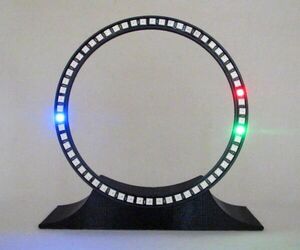
Desktop Equinox Clock
"Measuring Time The human mind has been fascinated by devices that keep track of time for thousands of years. A wide range of ingenious methods have been employed by different cultures including Chinese marked candles, Egyptian sundials and Roman clepsydrae, that used water pouring from a container to mark the passing hours. The classic hourglass (still useful for boiling an egg) led on to more sophisticated mechanical clocks from Europe. The development of these technologies has continued in search of ever-more accurate means to measure the passage of time. The evolution of the cheap wristwatch at the end of the 20th century used quartz crystals to keep time and they became the dominant timekeeping technology until the arrival of the smart phone. Today, we have atomic clocks that can keep an accuracy of one second in 300,000,000 years!" [...]
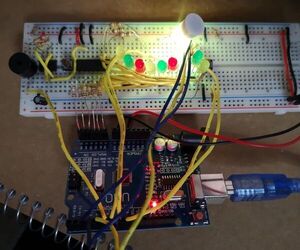
Match the Color Game Using 555, 4017 and RGB LED
"I created a circuit in which random colors are picked and where the user must attempt to match the colors as many times as possible for a high score as they blink on and off from left to right at a certain speed. The score and the info are displayed on the serial monitor. The buzzer also makes three unique sounds one for matching, mismatching, and a tune for a new high score. The project is quite simple and not too complex to understand. I've created a diagram on TinkerCAD as well as a working circuit in real life. Supplies: - 1x Arduino UNO - 1x Breadboard - 1x Buzzer - LEDs (4x yellow, 3x green, 2x red) - RBG LED - Resistors (12x 10k, 6x 330) - 1x 100 F Polarized Capacitor - Wires - 1x Pushbutton - 1x 555 Timer - 1x 4017 Decade Counter - 1x Potentiometer (Optional)" [...]
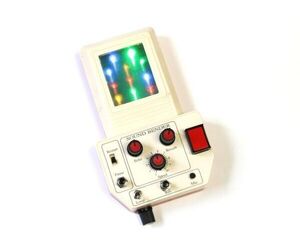
LED & Sound Bending Machine
"On one of my regular trips to the junk store, I came across an old racing car game. The game itself was pretty lame but what caught my attention was the case. The design was pure retro awesomeness and I knew I had to build something with it. After a little thought, I decided to combine a few other builds I have done in the past to make a sound bender with dancing LED's. A sound bender is really just that. You can record sounds into a small IC via a mic and then twist a potentiometer to change the pitch." [...]
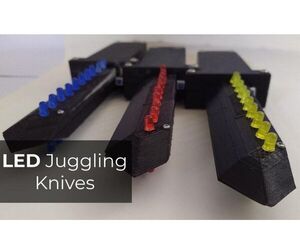
LED Juggling Knives
"This project was inspired by one of my friends, who is an avid juggler. He was looking for glow in the dark juggling balls and I wanted to try my hand in building it. As I worked through the design I realised that it would be much easier to build knives instead of juggling balls and I moved forward with that. With my knowledge of the 4017 IC, I decided to add a bit of flourish to the lights, which are now in the form of LEDs, and that is how I ultimately ended up with this project. A set of juggling knives that can be also used in the dark for better visuals. The LEDs are lit in a sequence, just like a led chaser." [...]
Advanced Silicone Mold Making Techniques for Epoxy Casting
"In our last instructable with Phillip, we went over the basics for making simple silicone molds in a home workshop with as few specialty tools and supplies as possible. We're stepping up our game and introducing some more advanced techniques for making complete acrylic mold masters and working with different silicone formulations that require some extra tools and know-how. Check out the full video below to see his process as you follow along in this guide. Supplies:Supplies: Inkscape - Free and Open Source Vector Based Design Software: https://inkscape.org 1/8" Cast Acrylic: https://www.mcmaster.com/8560K262/ 3/8" Cast Acrylic: https://www.amazon.com/gp/product/B01FGSDQL0 Nitrile Gloves *Warning! Latex gloves will inhibit the silicone curing process, do not use them for any part of this project*: https://www.jamestowndistributors.com/product/product-detail/2182 Isopropyl Alcohol Metal Spatulas: https://www.amazon.com/gp/product/B07MDH6Q2X Smooth-On Mold Star 30 (coming soon to totalboat.com! ): https://www.reynoldsam.com/product/mold-star/ Paint Pots: http://www.totalboat.com/product/plastic-paint-pails/ Sci-Grip 3 Acrylic Solvent: https://www.mcmaster.com/7528A13/ Dropper Bottles and Syringes: https://www.amazon.com/Dispensers-Applicator-Kit-Precisely-Dispensing/dp/B078VM7K66/ Cuticle Trimmer: https://www.amazon.com/IVON-Cuticle-Trimmer-Pusher-Remover/dp/B08CZ4QRYW Drill Mixers: https://www.amazon.com/gp/product/B000I1VHG2 Free TotalBoat Pour Volume Calculator: http://www.totalboat.com/epoxy-calculator/" [...]
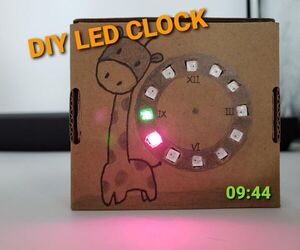
ESP32 Wifi Clock With WS2812
"Many times I woke up in the middle of the night and wanted to check the time. I need to turn on the lights or wake up the phone to view. When I turn on the light or phone, the light from the light or phone, dazzled me. I wanted to make a clock with the shimmer that can be placed in bedroom. This tutorial shows how to light a NeoPixel LED and make a simple clock with 12 LED ring. I hope it is helpful for beginners to build a project." [...]
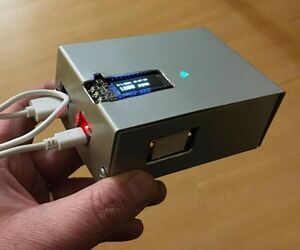
CO2 Monitoring As an Anti-Covid19 Measure
"Here, we propose an open-source, portable, autonomous, cheap and easy-to-use device to monitor and record the concentration of CO2 in ambiant air in real-time. Using CO2 as a proxy for respiratory aerosols, the device can help define best practices regarding the ventilation of closed space (an important anti-Covid19 measure). Starting from early 2020, the advent of the Covid19 pandemic has had a profound impact on the daily lives of billions of people. The perspective of active vaccines becoming available as soon as early 2021 has shone a ray of light on an otherwise dire situation. However, it is expected that as much as 70% of a country's population will have to be vaccinated in order to stop the spreading of the virus there. Even for countries with excellent medical infrastructures, reaching this aim represents a difficult and uncertain challenge." [...]

Easy Joule Thief Circuit
"A joule thief takes a low DC voltage and boosts it up to a higher voltage. You can even take a battery that other devices will consider to be drained and get a bit more of the energy out of it. You won't get much current from it, but you can get enough to power a 3 volt LED with a battery that's drained to less than a volt. That's why it's referred to as a joule thief. It's almost like stealing energy from a dead battery. By the way, some people call it a zombie circuit for this same reason." [...]

H-Bridge Motor Driver with Integrated Current Sense and Regulation using DRV8874
"In past, we have published many brushed dc motor driver boards for various projects and usually, they have some sort of limitations, as some of them are large in size, require large size heatsink, doesn’t have current feedback, they don’t have overload protection, some require external large size current shunt resistor and after all, recently we have found the amazing DRV8874 chip from Texas instruments that has some amazing features and protections features. It has a small package and can handle high current without a heatsink. We quickly become fans of this chip, and after a few tests and experiments, we are sharing this open-source module. This chip can be used with PWM/DIR input, PWM input, and 2 x Half-Bridge for dual motor control. We have tested this project with PWM/DIR inputs, and all inputs and outputs of the chip are accessible using the header connector. Refer to the datasheet of DRV8874 to explore other features and configure the board as per requirement." [...]
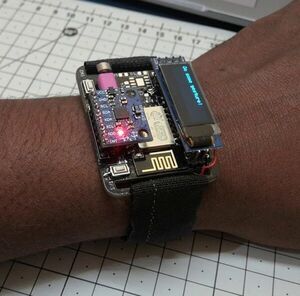
Gesture Detection Using Machine Learning
"Edge computing a ML model on ESP8266 and finding different gesture made with hand. The world is certainly getting better everyday at technology based on gestures because it’s very intuitive, easy to use and clearly makes the interaction with gadgets and things around you futuristic and fancy! So, just to be on the trend we’ll be taking the watch we built in the previous hackster project and plunge in some ML and see if we can detect what kind of gesture we are performing, and maybe in upcoming tutorial we can use this gesture to perform some very cool projects based on this. Supplies: These are the list of products which can help you do this project with ease(Affiliate Link) Esp12E OLED display MPU6050 Haptic motor(exact one) Haptic motor(alternative) 3.3V regulator 105mah battery Velcro HeaderPins Angled Header Pins Wires FTDI Male USB PCB Soldering Gun Soldering Lead Foam sheets" [...]
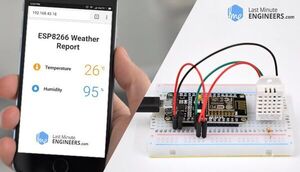
Interface DHT11 DHT22 w/ ESP8266 NodeMCU Using Web Server
"Have you ever wanted to have sensors scattered all around your house and garden reporting their temperature regularly to a central server? Then, this IoT project might be the solid launching point for you! This project uses ESP8266 NodeMCU as the control device that easily connects to existing WiFi network & creates a Web Server. When any connected device accesses this web server, ESP8266 NodeMCU reads in temperature & relative humidity from the DHT11, DHT22/AM2302 sensor & sends it to the web browser of that device with a nice interface. Excited? Let’s get started!" [...]
That's all Folks!



